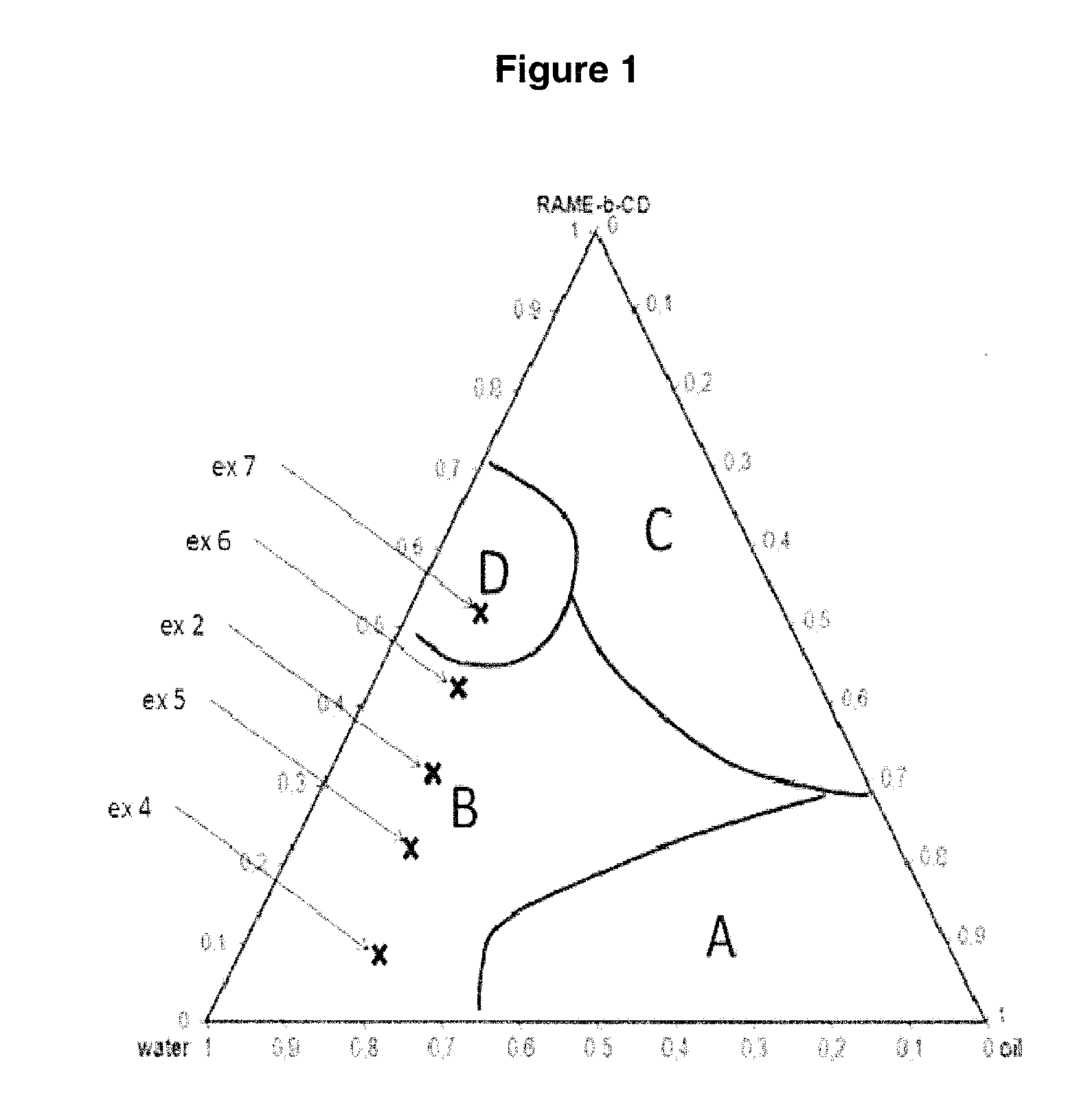Hydroformylation of triglycerides in a self-emulsifying medium
a technology of triglyceride and self-emulsification medium, which is applied in the direction of fatty acid chemical modification, organic chemistry, chemistry apparatus and processes, etc., can solve the problems of complex recycling of catalysts, large disadvantages of homogeneous medium, and high cost of recycling of catalysts
- Summary
- Abstract
- Description
- Claims
- Application Information
AI Technical Summary
Benefits of technology
Problems solved by technology
Method used
Image
Examples
example 1
Production of the Phase Diagram for the Water / Triolein / Substituted Cyclodextrin (CD) System at t=2 Min
[0056]This diagram is produced by varying the weight proportions between the components. The results are presented in FIG. 1. The proportions are calculated in the following way:
%(i)=wiwtotal=(wiwCD+wwater+wtriolein)
wi being the weight of the compound of which it is desired to determine the proportion.
[0057]Since emulsions are temperature-dependent, the diagram was produced at a temperature of 80° C. (temperature used for the catalytic tests). The procedure used is the following:
[0058]Predetermined amounts of RAME-β-CD and of triolein (cf. Table 1a, tubes 1 to 4) are placed in a test tube equipped with a magnetic stirrer. A certain amount of water is then added to each tube. The medium is left to stir (magnetic bar at 1400 revolutions / min) in an oil bath at 80° C. for 20 min. The stirring is then stopped. Two minutes after the stirring has stopped, the test tube is removed from the ...
example 2
Reaction for Hydroformylation of a Triglyceride, Triolein, in a Self-Emulsifying System According to the Invention
[0064]The reaction scheme is the following:
[0065]6.2 ml of an aqueous solution containing 3.05 mmol (4 g) of partially methylated β-cyclodextrins (RAME-β-CD) having an average molar mass of 1310 g·mol−1 and an average degree of substitution of 1.8 per glucoside unit, 0.029 mmol (7.5 mg) of (acetylacetonato)dicarbonyl rhodium(I) and 0.15 mmol (85 mg) of tri(meta-sulfonatophenyl)phosphine trisodium salt are placed in a 25 ml autoclave containing 1.9 mmol (1.8 ml) of triolein (i.e. 5.8 mmol of internal C═C double bonds).
[0066]This system corresponds to the proportions given in FIG. 1 on the phase diagram. The autoclave is heated to 80° C., pressurized under 50 bar of a CO / H2 mixture in equimolar proportion, and the stirring is regulated at 1400 revolutions / minute for 18 hours.
[0067]After the stirring has stopped, an emulsified phase containing the oil (initial products and ...
examples 3 to 7
Influence of the Amount of Substituted CD on the Hydroformylation Reaction of Example 2
[0070]These examples were carried out under the same experimental conditions in terms of time, pressure and temperature and also with the same catalytic agents as example 2. They show the influence of the amount of CD on the hydroformylation reaction.
[0071]The relative positions of examples 4 to 7 on the phase diagram previously produced are given in FIG. 1. Experiment 3 is an example without cyclodextrin and is given by way of comparison. It can be shown that domain B is a zone which makes it possible to have a significant conversion and selectivity. Indeed, example 7, located in domain D, shows a decrease in the selectivity of the hydroformylation. The specific experimental conditions and also the results are collated in table 2 below.
TABLE 2Weight ofRAME-β-ConversionAldehydeRAME-β-CDCD / triglyceridesof doubleselectivityExamples(g)mole ratiobonds (%)(%)30 / / / 0 / / / 40.50.20562520.821984672.883978793....
PUM
| Property | Measurement | Unit |
|---|---|---|
| temperature | aaaaa | aaaaa |
| mole ratio | aaaaa | aaaaa |
| pressure | aaaaa | aaaaa |
Abstract
Description
Claims
Application Information
 Login to View More
Login to View More - R&D
- Intellectual Property
- Life Sciences
- Materials
- Tech Scout
- Unparalleled Data Quality
- Higher Quality Content
- 60% Fewer Hallucinations
Browse by: Latest US Patents, China's latest patents, Technical Efficacy Thesaurus, Application Domain, Technology Topic, Popular Technical Reports.
© 2025 PatSnap. All rights reserved.Legal|Privacy policy|Modern Slavery Act Transparency Statement|Sitemap|About US| Contact US: help@patsnap.com



